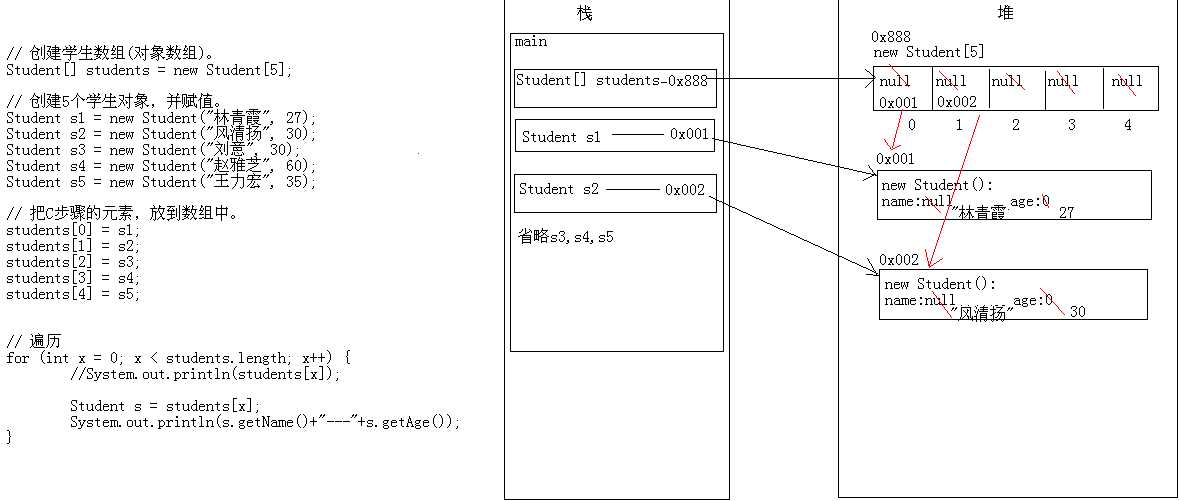标签:
1:对象数组(掌握)
(1)数组既可以存储基本数据类型,也可以存储引用类型。它存储引用类型的时候的数组就叫对象数组。
(2)案例:
用数组存储5个学生对象,并遍历数组。
public class Student {
// 成员变量
private String name;
private int age;
// 构造方法
public Student() {
super();
}
public Student(String name, int age) {
super();
this.name = name;
this.age = age;
}
// 成员方法
// getXxx()/setXxx()
public String getName() {
return name;
}
public void setName(String name) {
this.name = name;
}
public int getAge() {
return age;
}
public void setAge(int age) {
this.age = age;
}
@Override
public String toString() {
return "Student [name=" + name + ", age=" + age + "]";
}
}
/*
* 我有5个学生,请把这个5个学生的信息存储到数组中,并遍历数组,获取得到每一个学生信息。
* 学生:Student
* 成员变量:name,age
* 构造方法:无参,带参
* 成员方法:getXxx()/setXxx()
* 存储学生的数组?自己想想应该是什么样子的?
* 分析:
* A:创建学生类。
* B:创建学生数组(对象数组)。
* C:创建5个学生对象,并赋值。
* D:把C步骤的元素,放到数组中。
* E:遍历学生数组。
*/
public class ObjectArrayDemo {
public static void main(String[] args) {
// 创建学生数组(对象数组)。
Student[] students = new Student[5];
// for (int x = 0; x < students.length; x++) {
// System.out.println(students[x]);
// }
// System.out.println("---------------------");
// 创建5个学生对象,并赋值。
Student s1 = new Student("林青霞", 27);
Student s2 = new Student("风清扬", 30);
Student s3 = new Student("刘意", 30);
Student s4 = new Student("赵雅芝", 60);
Student s5 = new Student("王力宏", 35);
// 把C步骤的元素,放到数组中。
students[0] = s1;
students[1] = s2;
students[2] = s3;
students[3] = s4;
students[4] = s5;
// 看到很相似,就想循环改
// for (int x = 0; x < students.length; x++) {
// students[x] = s + "" + (x + 1);
// }
// 这个是有问题的
// 遍历
for (int x = 0; x < students.length; x++) {
//System.out.println(students[x]);
Student s = students[x];
System.out.println(s.getName()+"---"+s.getAge());
}
}
}
2:集合(Collection)(掌握)
(1)集合的由来?
我们学习的是Java -- 面向对象 -- 操作很多对象 -- 存储 -- 容器(数组和StringBuffer) -- 数组
而数组的长度固定,所以不适合做变化的需求,Java就提供了集合供我们使用。
(2)集合和数组的区别?
A:长度区别
数组固定
集合可变
B:内容区别
数组可以是基本类型,也可以是引用类型
集合只能是引用类型
C:元素内容
数组只能存储同一种类型
集合可以存储不同类型(其实集合一般存储的也是同一种类型)
(3)集合的继承体系结构?
由于需求不同,Java就提供了不同的集合类。这多个集合类的数据结构不同,但是它们都是要提供存储和遍历功能的,
我们把它们的共性不断的向上提取,最终就形成了集合的继承体系结构图。
Collection
|--List
|--ArrayList
|--Vector
|--LinkedList
|--Set
|--HashSet
|--TreeSet
(4)Collection的功能概述(自己补齐)
A:添加功能
B:删除功能
C:判断功能
D:获取功能
E:长度功能
F:交集(了解)
G:把集合转数组(了解)
(5)Collection集合的遍历
A:把集合转数组(了解)
B:迭代器(集合专用方式)
(6)迭代器
A:是集合的获取元素的方式。
B:是依赖于集合而存在的。
C:迭代器的原理和源码。
a:为什么定义为了一个接口而不是实现类?
b:看了看迭代器的内部类实现。
(7)Collection集合的案例(遍历方式 迭代器)
集合的操作步骤:
A:创建集合对象
B:创建元素对象
C:把元素添加到集合
D:遍历集合
A:存储字符串并遍历
import java.util.Collection;
import java.util.ArrayList;
import java.util.Iterator;
public class CollectionDemo {
public static void main(String[] args) {
//创建集合对象
Collection c = new ArrayList();
//创建并添加元素
c.add("hello");
c.add("world");
c.add("java");
//遍历集合
Iterator it = c.iterator();
while(it.hasNext()) {
String s =(String) it.next();
System.out.println(s);
}
}
}
B:存储自定义对象并遍历
public class Student {
private String name;
private int age;
public Student(){}
public Student(String name,int age) {
this.name = name;
this.age = age;
}
//getXxx()/setXxx()
}
import java.util.Collection;
import java.util.ArrayList;
import java.util.Iterator;
public class StudentDemo {
public static void main(String[] args) {
//创建集合对象
Collection c = new ArrayList();
//创建学生对象
Student s1 = new Student("林青霞",27);
Student s2 = new Student("风清扬",30);
Student s3 = new Student("刘意",30);
Student s4 = new Student("武鑫",25);
Student s5 = new Student("刘晓曲",16);
//添加元素
c.add(s1);
c.add(s2);
c.add(s3);
c.add(s4);
c.add(s5);
//遍历集合
Iterator it = c.iterator();
while(it.hasNext()) {
Student s = (Student)it.next();
System.out.println(s.getName()+"---"+s.getAge());
}
}
}
3:集合(List)(掌握)
(1)List是Collection的子接口
特点:有序(存储顺序和取出顺序一致),可重复。
(2)List的特有功能:(自己补齐)
A:添加功能
B:删除功能
C:获取功能
D:迭代器功能
E:修改功能
(3)List集合的特有遍历功能
A:由size()和get()结合。
B:代码演示
//创建集合对象
List list = new ArrayList();
//创建并添加元素
list.add("hello");
list.add("world");
list.add("java");
//遍历集合
Iterator it = list.iterator();
while(it.hasNext()) {
String s =(String) it.next();
System.out.println(s);
}
System.out.println("----------");
for(int x=0; x<list.size(); x++) {
String s =(String) list.get(x);
System.out.println(s);
}
(4)列表迭代器的特有功能;(了解)
可以逆向遍历,但是要先正向遍历,所以无意义,基本不使用。
(5)并发修改异常
A:出现的现象
迭代器遍历集合,集合修改集合元素
B:原因
迭代器是依赖于集合的,而集合的改变迭代器并不知道。
C:解决方案
a:迭代器遍历,迭代器修改(ListIterator)
元素添加在刚才迭代的位置
b:集合遍历,集合修改(size()和get())
元素添加在集合的末尾
(6)常见数据结构
A:栈 先进后出
B:队列 先进先出
C:数组 查询快,增删慢
D:链表 查询慢,增删快
(7)List的子类特点(面试题)
ArrayList
底层数据结构是数组,查询快,增删慢。
线程不安全,效率高。
Vector
底层数据结构是数组,查询快,增删慢。
线程安全,效率低。
LinkedList
底层数据结构是链表,查询慢,增删快。
线程不安全,效率高。
到底使用谁呢?看需求?
分析:
要安全吗?
要:Vector(即使要,也不使用这个,后面再说)
不要:ArrayList或者LinkedList
查询多;ArrayList
增删多:LinkedList
什么都不知道,就用ArrayList。
(8)List集合的案例(遍历方式 迭代器和普通for)
A:存储字符串并遍历
B:存储自定义对象并遍历
标签:
原文地址:http://www.cnblogs.com/canceler/p/4615275.html